***
Japan trip
Day 11 - 16th June - Peace Memorial Museum, Hiroshima (Part 2)
Next I entered the Peace Memorial Museum.
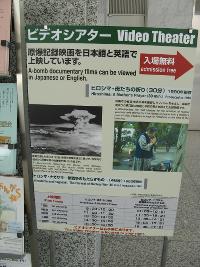
Documentaries they were showing. Typically, one simplistically equated peace to nuclear disarmament.
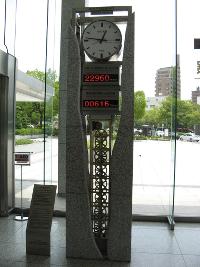
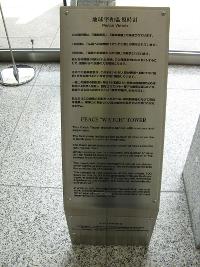
Peace 'Watch' Tower. It counts the days since the Hiroshima Incident and the last nuclear test. Ironically, Japan is big on nuclear energy today.
Also: "The cogwheel at the top rotates 100 times per minute, but it will spin faster if the earth shows signs of being in danger. If it reaches the immovable cogwheel at the bottom, the clock will automatically self-destruct." (the self-destruction mechanism of the clock is probably a nuclear bomb)
Note that this clock is very nuclear weapons oriented. When (knowing humanity, it's when rather than if) we have weapons more destructive than nuclear ones, I wonder what they'll do.
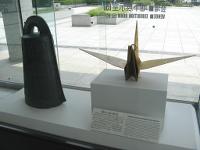
Bell and Crane of Children's Peace Monument
At about this time, the museum was swarmed by schoolkids (not in uniform - there must be a guideline as to when they venture out in uniform and when they go in civvies). I don't know why I was unfortunate enough to keep encountering them.
Compared to Yushukan (the Yasukuni Shrine museum) this one a lot more accurate and balanced. For example, they called it the 2nd Sino-Japanese War rather than the "China incident".
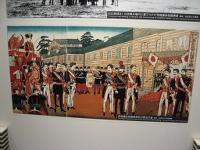
Emperor Meiji and friends. Love the moustaches.
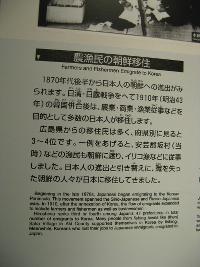
19th century labour flows between Japan and Korea - in both directions. Some other panel talked about Koreans forced to work in Japanese factories who "survived harsh conditions only to die in the Atomic bombing", which was quite a sly dig.
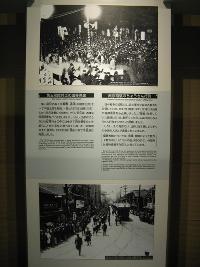
Japanese Militarism. In 1937 Hiroshima had a lantern parade celebrating the fall of Nanjing.
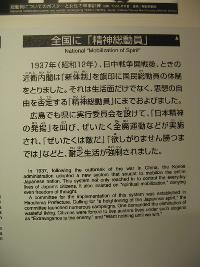
Japanese National Education:
"National "Mobilization of Spirit"
In 1937, following the outbreak of the war in China, the Konoe administration adopted a new system that sought to mobilize the entire Japanese nation. This system not only reached in to control the everyday lives of Japan’s citizens, it also insisted on “spiritual mobilization,” denying even freedom of thought.
A committee for the implementation of this system was established tn Hiroshima Prefecture. Calling for "a heightening of the Japanese spirit," the committee launched numerous campaigns. One demanded the elimination of wasteful living. Citizens were forced to live austere lives under such slogans as “Extravagance is the enemy,” and "Want nothing until we win.""
As one might know, their National Education was extremely effective at indoctrinating the populace and discouraging questioning of the regime, allowing them to win a string of victories.

Emergency rations and substitute matches
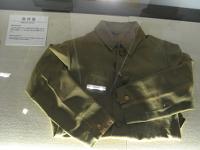
National Uniform
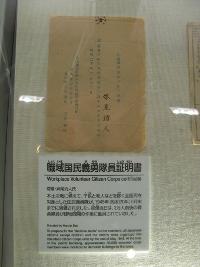
Workplace 'Volunteer' Citizen Corps certificate (Japanese Civil Defence cert)
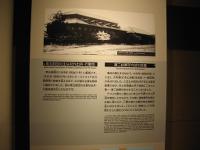
"In early 1945, with Japan's war situation worsening, the Imperial Headquarters decided to prepare for a "decisive battle for the mainland" and began calling loudly for "100 million deaths with honor.""
Estimated casualties from the 2 bombings: 105,000 (deaths without honour). Therefore the bombing of Hiroshima and Nagasaki saved about 99 million lives (minusing off some for air raids and rounding errors).
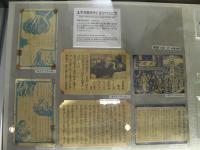
"No warning was given prior to the atomic bombing" - Oh please.
Flyers distributed by the Allies.

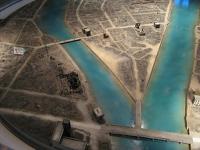
Hiroshima model: before and after
Of course, they brought up other reasons (than ending the war) for the atomic bombings. One was that they needed to show that the expensive Manhattan Project was a success.
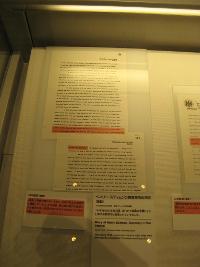
Replica diary of Henry Stimson, Secretary of War. In it he says he's afraid Japan might be bombed so thoroughly that the Atomic Bomb's efficacy will not be apparent. Indeed, they did not target potential A-bomb targets in conventional bombing so the effects of the A-bomb would be clearer. Yet, unfortunately for those who cannot read English, they conveniently did not translate the part before that: "I did not want to have the United States get the reputation of outdoing Hitler in atrocities"
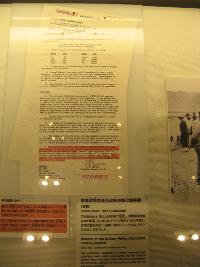
Minutes of the Military Policy Committee meeting (replica): the Japanese were chosen as a target because they would not be as able to get information from the bomb as the Germans.
One reason Hiroshima was selected as a target (besides being a military hub): there were no POW camps there. Kyoto was removed from the list to make postwar governance easier.
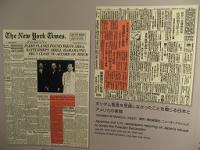
Juxtaposition of US and Japanese newspaper on Japan's refusal to accept the Potsdam Declaration. The museum the Japanese had said they needed more time to think about it, but the Allies claimed that they had refused it.
It seems the problem revolved around the word Mokusatsu ("黙殺"), which can mean:
1) Take no notice of
2) Treat with silent contempt
3) Ignore
4) Remain in a wise and masterly inactivity
Supposedly it was mistranslated as the second when it should have been translated as the third (i.e. "No comment"). Yet, Suzuki Kantaro's rejection was reported in the Asahi Shinbun on 28 July, and Hiroshima was bombed on August 6th - 9 days later. Given that the Potsdam Declaration was an ultimatum, I don't think one can justifiably argue that this did not constitute a rejection.
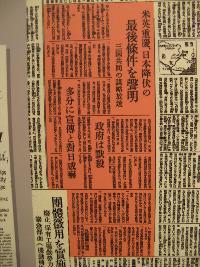
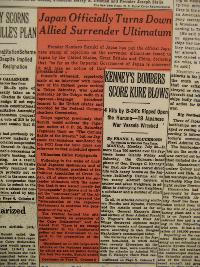
Newspaper articles in question
They had a pair binoculars probably used by the crew of the plane to observe the city after the bomb - donated by a Japanese guy. I have no idea how he got his hands on it. Maybe it fell out of the plane.
On every Atomic Bomb test since 1968, the Mayor of Hiroshima has telegraphed a protest (I'm not sure if Nagasaki does that - maybe being bombed second they're less driven about these things).
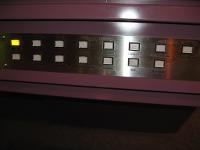
There was an information machine with a stunning number of languages: English, French, Portuguese (mentioned in English), German, Italian, Spanish, Russian, Malay, Chinese, Korean, Tamil (?), Indonesian, Tagalog, Hindi, Arabic
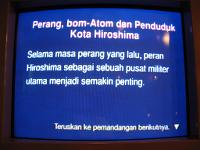
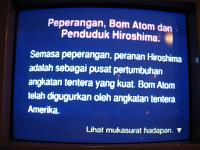
Can you tell which is Malay and which is Indonesian?
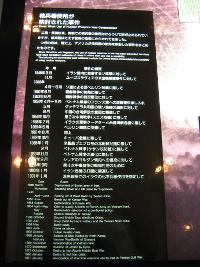
"Times When Use of Nuclear Weapons Was Contemplated"
This was really silly, like how conspiracy theorists take the slightest off-hand remark by some minor official as "proof" that the Government is planning to poison the water supply with fluorine. I'm sure the list of times Japan contemplated surrender in World War II was a significant fraction of this total.
Mere contemplation is not a good indicator of likely intent. For example, there are scales to measure how suicidal suicidal people are (sample). Depending on how well-formed your plan is, how many prior attempts you have made, what your mood is at the time of evaluation, your social support systems and other factors, your suicide risk is accordingly assessed.

There was also a list of accidents involving nuclear weapons. This was also quite silly, because civilian nuclear power (which Japan is very into) also has had many accidents (conveniently not listed). The most famous would be the Three Mile Incident in 1979. Indeed, perhaps what this list (and the one above us) shows us is that nuclear weapons are not as dangerous as they are claimed to be (one might also note that there have been many more accidents involving non-nuclear weapons).

"The Cold War wound down in 1989 as movements opposing environmental contamination caused by nuclear testing gained momentum"
I don't know if it's deliberate, but there's the suggestion that these movements led to the Cold War ending.
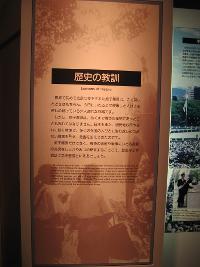
"Lessons of History: We must never forget that nuclear weapons are the fruits of war. Japan, too, with colonization policies and wars of aggression inflicted incalculable and irreversible harm on the peoples of many countries. We must reflect on war and the causes of war, not just nuclear weapons."
At least they acknowledge both their past misdeeds and that simplistically equating nuclear weapons to war is silly.
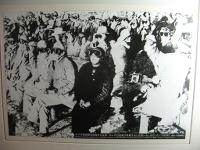
Nevadans watching a nuclear test. Good luck to them.
The US sent soldiers to test sites prematurely. Allegedly this was to test the effects of radiation on them.
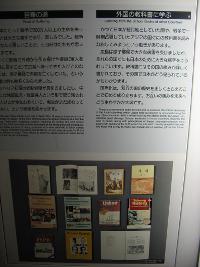
Against National Education: "There is a movement today to read and re-evaluate the school textbooks of the Asian countries which Japan held as colonies or occupied during the war. Hiroshima was dealt a severe blow by the atomic bomb, but Japan, too, inflicted great damage. School textbooks in those countries describe the pain in detail, along with perceptions of Japan. Internationalization must begin with speaking the truth about the role each country played in the war. We must find a way to make our mutual pain a positive gift for the future."
The "Social and Economic History of Modern Singapore" is there. Hurr hurr. And Brunei teaches History in English!

Nuclear Warhead Charts. Despite the museum's age they bothered updating the numbers.
The USSR had a lot of warheads, but IIRC many of them didn't work, so the true total was lower.
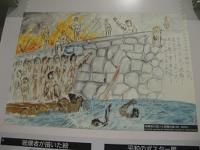
Painting of bomb aftermath
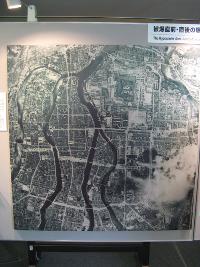

Aerial photographs of Hiroshima: Before and After

Hi-tech video selection console
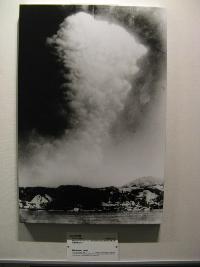
Hiroshima mushroom cloud - after 40 minutes
Next was the part of the museum with gruesome artifacts and horrible stories.
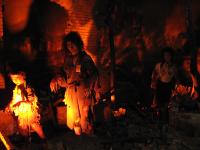
Setting the tone was an inferno scene


Locks of hair from a 13 year old girl
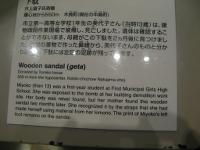
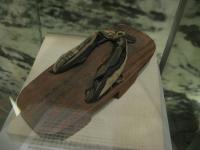
Wooden sandal with footprint
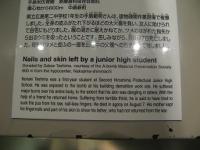
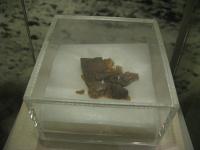
Nails and skin of a junior high student: "Suffering from terrible thirst, he is said to have tried to suck the pus from his raw, nail-less fingers"
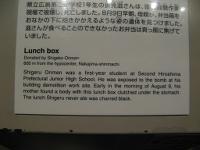
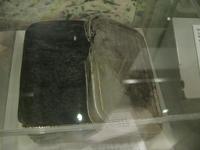
Lunch box
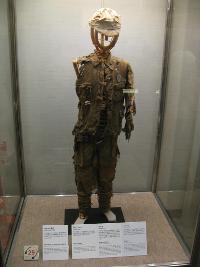
Scraps of clothing on a skeleton
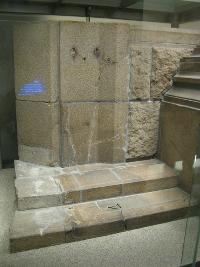
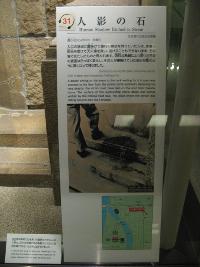
Human Shadow Etched in Stone
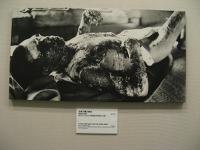
A man with burns over his entire body


